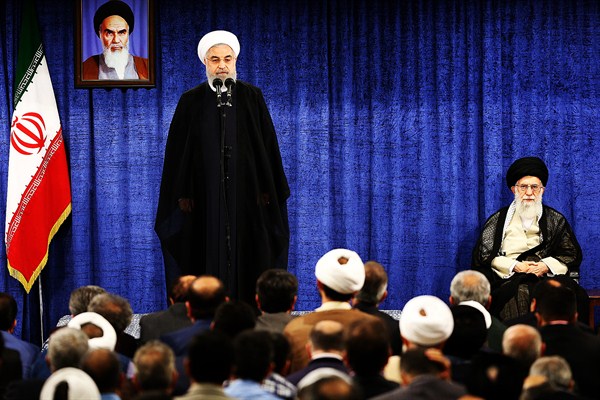Leaving the Iran nuclear deal is meant to put pressure on the Iranian government. But so far, most of the pressure is being felt by Iran’s citizens. Find out more when you subscribe to World Politics Review (WPR).
Iran’s steeply depreciating currency has plunged the country into a potentially explosive economic crisis, with several waves of public protests since December. The situation was exacerbated by U.S. President Donald Trump’s decision to violate the terms of the Iran nuclear deal and reimpose sanctions.
The Trump administration believes that by exerting “maximum pressure,” Iran will inevitably return to the negotiating table, or face implosion or even regime change. Economic strangulation is the core of this strategy. By sanctioning Iran’s oil industry and banking institutions, the United States plans to weaken Iran’s economy and provoke its sizable middle class, along with working and poor classes, to rise up against the state.
Trump believes his strategy is working. “Iran is falling apart,” he claimed in a Fox News interview in July. “They are having big protests all over the country, probably as big as they ever had before. And that all happens since I terminated that [nuclear] deal.” While the U.S. impact on these protests remains unclear, Iran is not falling apart. But it is preparing itself politically and economically to cope with the renewed American sanctions and potential internal upheaval.
Despite what the Trump administration imagines, leaving the Iran nuclear deal may not lead to regime change. Find out more in, With U.S. Sanctions Looming, Iran Faces a Potentially Explosive Economic Crisis for FREE with your subscription to World Politics Review.
In Iran, Crisis May Unify Rival Factions
Two weeks after President Donald Trump unilaterally withdrew the United States from the Iran nuclear deal in May, Secretary of State Mike Pompeo outlined the parameters of the administration’s “new Iran strategy” that he believes would lead to a “better deal” with Tehran. Iran predictably did not accept these sweeping demands. The Trump administration’s approach of both exerting maximum pressure on Iran and demanding maximum concessions has added a new element into Iran’s political scene that could have an unpredictable long-term outcome. Based on Tehran’s reaction so far, though, it doesn’t look like it will come to the negotiating table anytime soon. If anything, the new U.S. strategy could intensify the cold war in the Middle East.
Find out why breaking the Iran nuclear deal goes against the interests of both America and Iran. Read How the Sweeping U.S. Demands on Iran Will Roil Its Domestic Politics for FREE with your subscription to World Politics Review.
[marketing]ofie[/marketing]
Sanctions Will Hit Iran’s Economy, but That Won’t Help Iran’s Protesters
The popular demonstrations that have erupted periodically in Iran since December of 2017 offered a pretext for President Donald Trump to renege on the nuclear deal, which he pulled out of the following May, after having demonized the deal throughout his first year in office. But breaking the 2015 agreement by piling on sanctions pressure will undermine the very protesters the administration has vocally supported. The threat of new U.S. sanctions would also limit American leverage in pursuing regional stability and nonproliferation.
The Trump administration’s strategy could unite the country against what is perceived as a common enemy. Find out more, in Breaking the Iran Deal and Imposing New Sanctions Would Hurt Iranian Protesters Most for FREE with your subscription to World Politics Review.
Economic Pain of Sanctions Won’t Rein In Iran’s Regional Adventurousness
Trump’s policy of reimposing economic sanctions aims to impose “maximum pressure” on Iran in order to provoke a change of behavior in Iranian regional policy. Far from accomplishing its goals, the U.S. approach is strengthening the hand of Iran’s conservative hard-line factions. Meanwhile, growing regional tensions between Iran and its allies, on one side, and the U.S. and its Middle Eastern partners, on the other, create an unstable environment, making it very difficult for Iranian officials to effectively develop and reform the economy. Due to this instability, the regime finds itself forced to choose between a more democratic political system that is focused on socio-economic development and a securitized theocratic state that is merely focused on the revolution’s survival. The Islamic Republic in its current form, as a hybrid between elective bodies and clerical rule, is becoming more and more difficult to sustain, and U.S. sanctions are pushing Iran toward the latter option. Further international isolation would likely create a more authoritarian political regime in Iran that is more repressive in its internal policies and more politically adventurous in its foreign policy.
Reimposing sanctions on Iran has strengthened the conservative hard-liners, while doing nothing to change Tehran’s regional behavior. Find out more, in Iran’s Problems Go Beyond the Current Hard Line From the U.S. for FREE with your subscription to World Politics Review.
Learn more about the Iran nuclear deal, the economy of Iran, the impact of sanctions, and the possible outcomes of the Iran crisis in the searchable library of World Politics Review (WPR):
- Why Iran’s economy could be a time bomb, in With U.S. Sanctions Looming, Iran Faces a Potentially Explosive Economic Crisis
- How Tehran plans to deal with the U.S. demands, in How the Sweeping U.S. Demands on Iran Will Roil Its Domestic Politics
- Why the Trump administration’s Iran sanctions will backfire, in Breaking the Iran Deal and Imposing New Sanctions Would Hurt Iranian Protesters Most
- Why reimposing sanctions on Iran has strengthened the conservative hard-liners, while doing nothing to change Tehran’s regional behavior, in Iran’s Problems Go Beyond the Current Hard Line From the U.S.
[marketing]boilerplate[/marketing]
Editor’s Note: This article was first published in November 2018 and is regularly updated.

